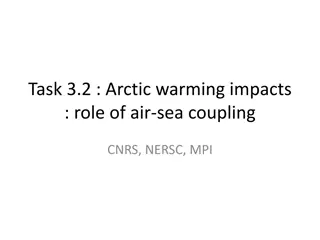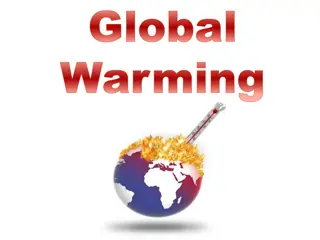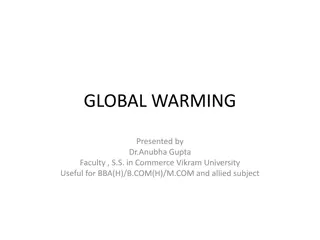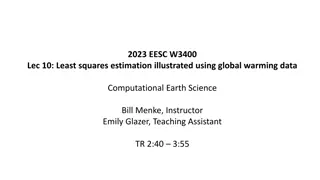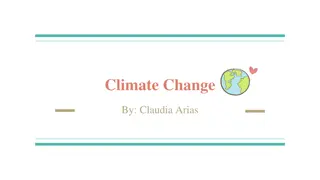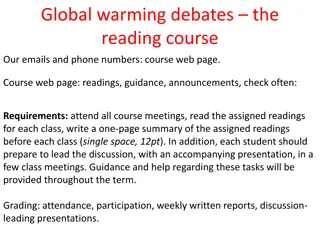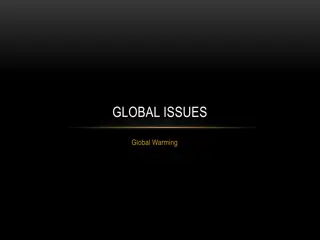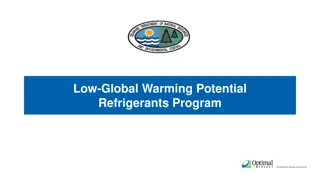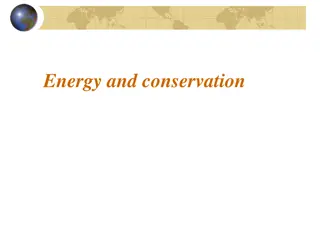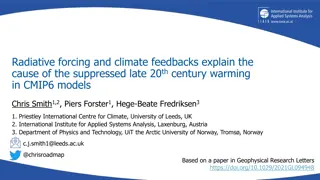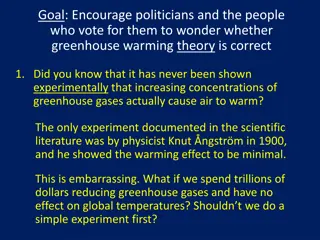Understanding Global Warming: Causes, Effects, and Solutions
Global warming, a result of both natural and human-induced factors, leads to detrimental impacts such as regional climate change, glacier melting, and the spread of diseases. This phenomenon disrupts ecosystems, agriculture, and biodiversity worldwide. Addressing global warming requires a collective effort towards reducing greenhouse gas emissions and implementing sustainable practices to mitigate its effects on our planet.
Download Presentation

Please find below an Image/Link to download the presentation.
The content on the website is provided AS IS for your information and personal use only. It may not be sold, licensed, or shared on other websites without obtaining consent from the author. Download presentation by click this link. If you encounter any issues during the download, it is possible that the publisher has removed the file from their server.
E N D
Presentation Transcript
Course e-Content Environmental Studies Global Warming Kyoto Protocol Kyoto Protocol Amendments
Global Warming The phenomenon of green house effect was first suggested by Archeniuss in 1986. Global warming affects the natural balance of environment. The average global atmospheric temperature is about 150C.This average temperature is maintained by green house gases. The natural greenhouse gases are carbon di oxide CO2, methane CH4, Nitrogen Oxides NOX and water vapor H2O. These gases are responsible to maintain the temperature up to 330C because in the absence of these gases the temperature would be -180C. These greenhouse gases traps the heat in the atmosphere and prevents a part of this heat escaping into the outer space. This heat makes our environment warm. The phenomenon of trapping heat by the atmosphere and creating the favorable condition for the sustenance of life is called Green House Effect. The level of Green House gases increase in the atmosphere and retain more radiation leading to enhanced Green House Effect, which in turn will increase the mean Global temperature. This is called Global Warming. The approx contribution of % of Green House gases to Global warming by CO2- 61%, CH4-15%, CFCs-11%, NOX-4% and other gases about 9%.Ozone in the troposphere act as Green House Gas.
Causes of Global warming Global warming causes can be categorized as follows: 1. Natural Causes 2. Anthropogenic Causes 1. Natural Causes: Release of Methane from Arctic Tundra and Wetlands. Volcanic activity El Nino Southern Oscillation (ENSO)
2. Anthropogenic Causes: Burning of Fossil fuels. Aerosols Land use change Farming and Forestry
Effects of Global warming Regional climate change: It is observed as long term change in pattern of average weather of a particular region of a globe. Glacier melting and Sea level rise: Increase in temperature due to global warming is causing melting of ice in polar region and on mountains. This causes increase in global sea level. Due to sea level rise the submergence of islands and coastal areas occur. Increase environmental hazards: Global warming causes desertification, draught and increase in intensity and frequency of cyclonic events.
Spreading of disease: Rise in temperature and rain fall changes will affect the distribution of mosquitoes which carry diseases like malaria, encephalitis, filariasis, chickengunia etc. the vector born and communicable diseases will spread certainly. Effect on Biodiversity: Global warning impacting on biodiversity because any species have evolved in many years to live within certain temperature range. With rapid increase in temperature, these species may not adopt or survive in this scenario. Effect on agriculture: Global warming will impact on agriculture and productivity of crops in all around the world. Due to increased level of CO2, high temperature and unpredictable precipitations events and modified weed, pest and pathogen pressure, the crop productivity would be influenced.
Kyoto Protocol The Kyoto Protocol is an international agreement which extends the 1992 United Nations Framework Convention on Climate Change (UNFCCC) that commits state parties to reduce greenhouse gas emissions, The Kyoto Protocol was adopted in Kyoto, Japan, on 11 December 1997 and entered into force on 16 February 2005. There are currently 192 parties. The Protocol enforces the principle of common but differentiated responsibilities. it acknowledges that individual countries have different capabilities and strength in combating climate change, owing their economic development, and therefore puts the efforts to reduce current emissions on developed countries on the basis that they are historically responsible for the current levels of greenhouse gases in the atmosphere.
The Kyoto protocol commits the developed countries including economies in transition to reduce emission of Green house gases by an average of 5.2% below 1990 levels during 2008-2012. The Kyoto Protocol applies to the six greenhouse gases listed in Annex A: Carbon dioxide (CO2), Methane (CH4), Nitrous oxide (N2O), Hydrofluorocarbons (HFCs), Perfluorocarbons (PFCs), and Sulphur hexafluoride (SF6). Annex I and Annex B Countries are the signatory nations to the Kyoto Protocol that are subject to caps on their emissions of Green House Gases and committed to reduction targets countries with developed economies. Annex I refers to the countries identified for reduction in the United Nations Framework Convention on Climate Change (UNFCCC) while the Annex B is an adjusted list of the countries identified under the more recent Kyoto Protocol. Annex B countries have their reduction targets formally stated.
India has ratified the second commitment period of the Kyoto Protocol that commits countries to contain the emission of greenhouse gases, reaffirming its stand on climate action. India became the 80th country to accept the amendment relating to the second commitment period of the Kyoto Protocol, the international emissions reduction treaty.
Kyoto Protocol Amendments The detailed rules for the implementation of the protocol were adopted at COP7 in Marrakesh, Morocco, in 2001, and are referred to as Marrakesh Accords. This first commitment period started in 2008 and ended in 2012. In Doha, Qatar on 8th Dec 2012, the Doha amendment to the Kyoto protocol was adopted. The amendment includes: 1. New commitment for Annex-1 parties to the Kyoto protocol who agreed to take on commitments in a second commitment period from 1st January 2013 to 31st Dec 2020. 2. The revised list of Green House Gases to be reported on by parties in the second commitment period. 3. Amendments to several articles of Kyoto protocol which specifically referred issues pertaining to the first commitment period and which needed to be updated for the second commitment period.









